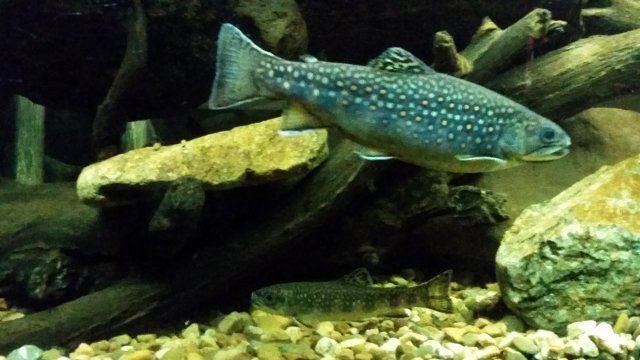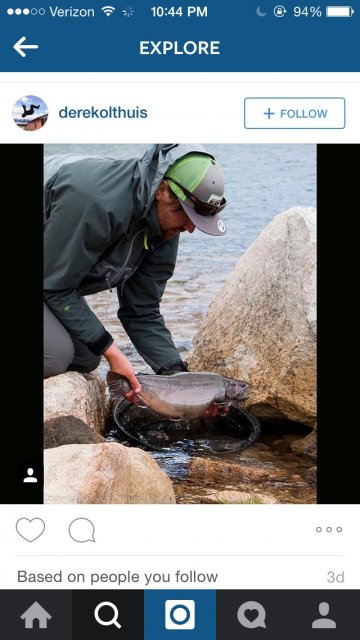Trout Tank
- Thread starter BrookKeeper
- Start date
You are using an out of date browser. It may not display this or other websites correctly.
You should upgrade or use an alternative browser.
You should upgrade or use an alternative browser.
Damn, that's a big gurl...Just came across this and reminded me of this post
Would you believe that these two fish are the same age, collected from the same stream on the same day a just over 2 years ago?
After loosing two trout recently, the tank was a little sad with one two trout in it. I had 3 large and three large and three small trout in the 180 gallon on campus, and the little guys were not doing well with "P" (the big bully male) harassing them at feeding time, they were beginning to lose weight and show signs of stress, so I brought them home. The crazy thing is that they were ALL roughly the same size I first set up the display tank. I first added 4 dominant individuals into the 180 gallon, significantly increased their feeding rate, and watched them take off growing. Once it became obvious that the smallest of the 4 was getting stressed, I brought her ("G", who just passed due to egg lock) home and added three more small fish. The first set of fish had about 1-2 inches on the second set, and as the first set continued to grow, the second set never did!

Two out of the three little guys that just came home are doing well, holding their own and getting more food than they used to hanging around with "P". The third and smallest guy was really stressed in the old tank and continues to struggle after the move, so I have currently isolated him in a chamber within my sump tank. I am not very confident that he is going to come back from his current state, and if he doesn't start feeding again soon, I will probably put him out of his misery. Four seems to be a comfortable number for my 125 gallon.
After loosing two trout recently, the tank was a little sad with one two trout in it. I had 3 large and three large and three small trout in the 180 gallon on campus, and the little guys were not doing well with "P" (the big bully male) harassing them at feeding time, they were beginning to lose weight and show signs of stress, so I brought them home. The crazy thing is that they were ALL roughly the same size I first set up the display tank. I first added 4 dominant individuals into the 180 gallon, significantly increased their feeding rate, and watched them take off growing. Once it became obvious that the smallest of the 4 was getting stressed, I brought her ("G", who just passed due to egg lock) home and added three more small fish. The first set of fish had about 1-2 inches on the second set, and as the first set continued to grow, the second set never did!

Two out of the three little guys that just came home are doing well, holding their own and getting more food than they used to hanging around with "P". The third and smallest guy was really stressed in the old tank and continues to struggle after the move, so I have currently isolated him in a chamber within my sump tank. I am not very confident that he is going to come back from his current state, and if he doesn't start feeding again soon, I will probably put him out of his misery. Four seems to be a comfortable number for my 125 gallon.
Would you believe that these two fish are the same age, collected from the same stream on the same day a just over 2 years ago?
After loosing two trout recently, the tank was a little sad with one two trout in it. I had 3 large and three large and three small trout in the 180 gallon on campus, and the little guys were not doing well with "P" (the big bully male) harassing them at feeding time, they were beginning to lose weight and show signs of stress, so I brought them home. The crazy thing is that they were ALL roughly the same size I first set up the display tank. I first added 4 dominant individuals into the 180 gallon, significantly increased their feeding rate, and watched them take off growing. Once it became obvious that the smallest of the 4 was getting stressed, I brought her ("G", who just passed due to egg lock) home and added three more small fish. The first set of fish had about 1-2 inches on the second set, and as the first set continued to grow, the second set never did!
View attachment 1132910
Two out of the three little guys that just came home are doing well, holding their own and getting more food than they used to hanging around with "P". The third and smallest guy was really stressed in the old tank and continues to struggle after the move, so I have currently isolated him in a chamber within my sump tank. I am not very confident that he is going to come back from his current state, and if he doesn't start feeding again soon, I will probably put him out of his misery. Four seems to be a comfortable number for my 125 gallon.
I didn't even see the little fish I thought you forgot a picture lol
What a great thread. It's nice to see something informative being posted again. Brookkeeper, your knowledge of trout seems profound. Questions: If egg lock is a real risk, is it easier to keep males? I am interested to know what the experiment demonstrated. What were the detrimental effects of silt? Is it possible to breed brook trout?
Thanks! Glad people seem to be enjoying the thread. Profound might be a stretch, but I have been working pretty closely with the species for three years now, and I always seem to be learning something new about them. I really enjoy sharing what I know. Now for the questions...What a great thread. It's nice to see something informative being posted again. Brookkeeper, your knowledge of trout seems profound.
This is a tough one. Since they are very difficult to sex before they mature, you would have to collect larger/older fish to be sure of the gender. Although this is speculation, I believe that a brookie old enough to sex would have a hard time adjusting to an aquarium. I have more basis for the belief that males are more aggressive than females, so keeping multiple males may prove hazardous as well. My big nasty male "P", was the dominant fish in my most aggressive cohort. "G", my egg locked lady, was the dominant fish in the cohort that I referred to as 'the lovers', because they just didn't display the aggression that I saw in the other three cohorts. I was unaware of gender during my experiments, and have only worked out a few individuals still to date, but I am convinced that males are more aggressive than females, even as juleniles.If egg lock is a real risk, is it easier to keep males?
The main results were that aggression was greatest early in the day, in fact, all activity was greatest in the morning, and watching brook trout in the evening was awfully boring. At times I saw no movement for two full hours leading up to dusk. Increased sediment means less interstitial space for the subordinates to tuck into, and this meant more aggression. I also saw more aggression at 12°C than I did at 18°C, but there are a few disclaimers to be made along with that result... You will have to read my thesis for that, believe it or not I am typing on my phone in the car right now, and it is getting old... (Don't worry, my wife is driving not me...)I am interested to know what the experiment demonstrated. What were the detrimental effects of silt?
Here again is a link to my thesis, if you are really interested in the negative effects of sedimentation, I would encourage you to skip to the discussion section, but the whole thing is a pretty stimulating read...
https://sites.google.com/site/clmayjmu/snow-thesis
Sure! I doubt if you would see any natural spawning behavior in captivity (unless anyone wants to give me a 500+ gallon setup, then maybe I could make it happen) but fish and game facilities all over the east coast breed then for stocking. I am hoping that I can milk some eggs off another female, although "H" is either not gravid yet or not giving up her eggs... I have attempted twice and expressed only waste so far, and I haven't felt eggs yet, although she is looking rather plump... I need to get in touch with my hatchery contacts again to see if I can get some experienced advice. I feel confident that if I can get some eggs, "P" is ready to give up some sperm. Then it is just a matter of maintaining good cold well oxygenated flow over the eggs. Elementary schools all over VA raise "trout in the classroom" (trout unlimited sponsored educational outreach) and eventually release fingerlings in local streams. Waiting to hear what everyone has to say about the release of captive fish, which I agree is a bad idea for a number of reasons. The funny thing is that VDGIF provides the eggs, encourages and even assists with releasing them, offering invert and fish collection and identification demos for the kids at the release sites. Perhaps the outreach opertunities outweighs the potential risk of introducing health issues to wild populations...Is it possible to breed brook trout?
Okay, just for fun... who knows what this guy is? he just came home from school today, also...
Beautiful Darter! Species? Looks like the elongated body of Ammocrypta sps. but much more colorful than any species I know of in that genus.
Roanoke logperch (Percina rex)Beautiful Darter! Species? Looks like the elongated body of Ammocrypta sps. but much more colorful than any species I know of in that genus.
Roanoke logperch (Percina rex)
That's your fish?! I thought P. rex was listed as federally endangered?



